 No matter how hard you try, you can’t capture lightning in a bottle twice.
No matter how hard you try, you can’t capture lightning in a bottle twice.
Depending on your rubric, the Nintendo Gameboy is the most successful portable system of all time. Sure, it might not be the highest grossing system ever (that would be the Nintendo DS, I believe), or the most graphically advanced experience (a single color would be nice), but it is the system that put portable gaming on the map. No more would we be stuck with Game & Watch or tiny Tigers; the Nintendo Gameboy was a real game system for real games with physics and powerups and everything. Super Mario Land may have been a whopping weirdo of a Mario game, but it was an experience that beat the pants off anything that claimed to be Mario’s so-called Cement Factory (look it up!). The Gameboy may be primitive by today’s standards (or the standards of anyone that is not enthralled by mushed peas), but its success was the first real example of a portable system being a viable system for the most dedicated (/easily bored) of gamers. Experiences that traced back to the arcade were finally available literally anywhere.
But nobody really cared about any of that, because, dammit, the Gameboy had Tetris.
Gameboy Tetris was ubiquitous. If there was one game that sold the Nintendo Gameboy, it was Gameboy Tetris. It was the only official way to fish out a 2-player mode on Nintendo hardware (and probably sold a few link cables as a result), but, more importantly, it was a puzzle game that could be played anywhere and everywhere. Sega may have eventually had Columns, but Nintendo was immediately associated with the one and only Tetris, and there wasn’t a man, woman, or child on God’s pea-green Earth that didn’t want a Gameboy with Tetris. Gameboy Tetris was pervasive long after other launch Gameboy titles were long forgotten (I’m sorry, who could forget Kwirk?), and it was all a testament to the unstoppable Russian juggernaut that was/is Tetris. After all, Gameboy Tetris is simply Tetris, 90% the same game that was created by some Alexey dude in Moscow a solid five years earlier. Yes, you can link the entire success of the Nintendo Gameboy to some random USSR denizen. How’s that for global relations?
So, when Nintendo needed to push the Nintendo 64, it seems only natural that they recruited some international Tetris-y dudes to sell their next system.
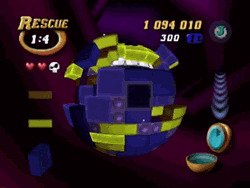 Tetrisphere began its life as “Phear”, a title created by H20 Entertainment, a Canadian game production company. Phear’s biggest difference between its original form and its eventual N64 version? It was intended to be an Atari Jaguar game, and was featured as such in the Winter of 1995. Now, everyone alive knows the sad tale of the Atari Jaguar, and how literally nothing could have ever saved that system (well, maybe an early, polished version of Typing of the Dead), so some would likely see it as a kindness that Nintendo rescued this poor, soon-to-be-forgotten software from the same fate as Bubsy. On the other hand, you can see Nintendo nakedly pulling the same stunt that catapulted the Gameboy into the stratosphere: here’s a cool puzzle game that could push our new videogame system. And, bonus, the advanced graphics of Phear/Tetrisphere could never be replicated on the meager Playstation hardware, so this is going to be the killer app of 1996! Look out, Mario 64, you’re going to have to take a backseat to the new Tetris, baby!
Tetrisphere began its life as “Phear”, a title created by H20 Entertainment, a Canadian game production company. Phear’s biggest difference between its original form and its eventual N64 version? It was intended to be an Atari Jaguar game, and was featured as such in the Winter of 1995. Now, everyone alive knows the sad tale of the Atari Jaguar, and how literally nothing could have ever saved that system (well, maybe an early, polished version of Typing of the Dead), so some would likely see it as a kindness that Nintendo rescued this poor, soon-to-be-forgotten software from the same fate as Bubsy. On the other hand, you can see Nintendo nakedly pulling the same stunt that catapulted the Gameboy into the stratosphere: here’s a cool puzzle game that could push our new videogame system. And, bonus, the advanced graphics of Phear/Tetrisphere could never be replicated on the meager Playstation hardware, so this is going to be the killer app of 1996! Look out, Mario 64, you’re going to have to take a backseat to the new Tetris, baby!
Unfortunately, it was not to be. 1996 came and went, and it was impossible to instantly port the partially completed Phear to the N64 to be the 100% completed Tetrisphere. Though all was not lost! This allowed H20 Entertainment to hit the next Christmas season goalpost, and Tetrisphere was uncut with all necessary bells and whistles by August of 1997. According to interviews, that extra time allowed for an additional second player mode (that was originally intended, but likely would have been dropped for an earlier release date), and, relatedly, the all-important frame-rate was improved so Tetrisphere could look that much more prettier. And I can’t help but notice that Tetrisphere is loaded with more modes and, frankly, character than the average puzzle game. There’s a lot to experience in Tetrisphere, and it’s likely a lot of that resulted from baking long enough in the oven.
But could Tetrisphere be the killer app of the Nintendo 64?
… Well, you can’t say it didn’t have a shot.
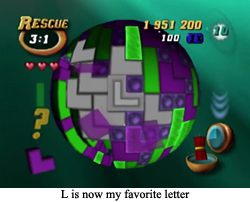 Tetrisphere is by no means Tetris. There are familiar “blocks”, but they’re not infinitely falling from some unseen heavens. In fact, you are responsible for dropping all blocks, and the challenge is figuring out exactly where on the sphere you’re supposed to drop said blocks. If you drop a shape exactly on a matching shape, and that shape is next to a shape of the exact same dimensions, then both blocks are going to disappear. Line up a few shapes of the same size, and you’ve got a lovely little chain reaction going that could spread across the surface of the entire sphere. Your goal is to peel layers off the sphere so the little robot dude trapped inside can be free to escape and do whatever robots do (conquer humanity?), so every block vanished is another step closer to your goal. Of course, if you drop a block on a non-matching square, you’re stuck with another cumbersome lump of useless obstructing your robot rescue. And just for an added bit of stress, if you make three mismatches, it’s game over. And it’s game over if you take too long, too. And it’s game over if you sneeze on the Pope, too, though that rarely comes up. Point is that there are a lot of ways to fail, and Tetrisphere seems like it wants to be challenging.
Tetrisphere is by no means Tetris. There are familiar “blocks”, but they’re not infinitely falling from some unseen heavens. In fact, you are responsible for dropping all blocks, and the challenge is figuring out exactly where on the sphere you’re supposed to drop said blocks. If you drop a shape exactly on a matching shape, and that shape is next to a shape of the exact same dimensions, then both blocks are going to disappear. Line up a few shapes of the same size, and you’ve got a lovely little chain reaction going that could spread across the surface of the entire sphere. Your goal is to peel layers off the sphere so the little robot dude trapped inside can be free to escape and do whatever robots do (conquer humanity?), so every block vanished is another step closer to your goal. Of course, if you drop a block on a non-matching square, you’re stuck with another cumbersome lump of useless obstructing your robot rescue. And just for an added bit of stress, if you make three mismatches, it’s game over. And it’s game over if you take too long, too. And it’s game over if you sneeze on the Pope, too, though that rarely comes up. Point is that there are a lot of ways to fail, and Tetrisphere seems like it wants to be challenging.
But the fun of Tetrisphere doesn’t come from the potential challenge, it comes from lining up all the blocks for thrilling chain reactions. There is nothing quite like cramming all the blocks into proper locations, guessing the shapes of the blocks on the lower levels, and watching as the whole sphere destructs after some carefully measured movements. It is very possible to clear entire layers in one wisely deduced drop. Heck, sometimes it even happens by accident! It’s equally electrifying when you drop a single piece, and, thanks to the natural geography of the sphere, layer after layer is obliterated, inevitably causing an instantaneous rush of dopamine. Look at all those blocks go boom! I did good!
And, after this happened a few times, it finally hit me: these poor saps invented Candy Crush a solid decade too early!
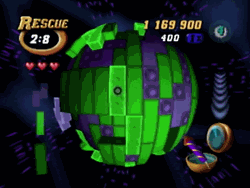 Tetrisphere works almost exactly like Candy Crush and its addictive ilk. You shift blocks/colors/candies from spot to spot, and, when they’re all properly aligned, you see a “connection” that eliminates a swath of shapes. Sometimes it’s just one or two blocks. Oftentimes, it’s a whole screen full of nonsense that seems to go on for minutes as blocks you couldn’t have even seen before all appear and instantaneously detonate into tiny pieces. You know you didn’t have anything to do with that enormous chain reaction, but you feel great anyway, because, dude, did you see how many points I just got? Friggin’ nailed it, man! And that’s how players instantly become addicted to these mobile match games: it feels amazing to be responsible for so much winning/destruction. I am become God, matcher of fruits.
Tetrisphere works almost exactly like Candy Crush and its addictive ilk. You shift blocks/colors/candies from spot to spot, and, when they’re all properly aligned, you see a “connection” that eliminates a swath of shapes. Sometimes it’s just one or two blocks. Oftentimes, it’s a whole screen full of nonsense that seems to go on for minutes as blocks you couldn’t have even seen before all appear and instantaneously detonate into tiny pieces. You know you didn’t have anything to do with that enormous chain reaction, but you feel great anyway, because, dude, did you see how many points I just got? Friggin’ nailed it, man! And that’s how players instantly become addicted to these mobile match games: it feels amazing to be responsible for so much winning/destruction. I am become God, matcher of fruits.
And Tetrisphere nailed that feeling back in 1997. Nintendo identified that, and hoisted that feeling onto a system that could have won the hearts of an entire videogame generation. But, alas, the Nintendo 64 was not a portable system, and, given the choice between the sweet happy feelings of Tetrisphere and playing around with an amnesiac with an unusually large sword, audiences chose the blade. Sorry, Tetrisphere, no one can say you didn’t try.
In more ways than one, Tetrisphere could have been the next Tetris, but it was not meant to be. Too late for the Gameboy, and too early for the mobile market. Tetrisphere: the middle child of failure.
FGC #465 Tetrisphere
- System: Nintendo 64. Could there be a remake in the future? No. No there can’t.
- Number of players: Two player mode is viable in this game, unlike some versions of Tetris. Unfortunately, two Tetrispheres on screen at one time is kind of nauseating, so screw that noise.
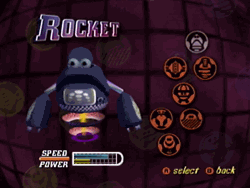 Favorite Bot: You’re supposed to take on the “control” of a handful of different robots, and each supposedly impacts a different stat like “speed” or “power”. But damned if I can tell much of a difference between the different automatons, so I’m just going to say… Rocket? He is first…
Favorite Bot: You’re supposed to take on the “control” of a handful of different robots, and each supposedly impacts a different stat like “speed” or “power”. But damned if I can tell much of a difference between the different automatons, so I’m just going to say… Rocket? He is first…- Opaque Fun: Hide & Seek mode is actually where the bulk of interesting modes are hiding, but you would never know it from such an innocuous title. It technically plays like normal “destroy the sphere” mode, but there are all sorts of fascinating additions, like “drill” (random extra “bombs” are around the sphere) or “tower” (an annoying tower has to be worked around at all times). This is where a lot of creativity shines through beyond the usual modes of your average puzzle game… and most people never even tried the mode in the first place. Who over the age of seven gets excited about hide & seek?
- So, did you beat it: Who has the time? Wasn’t this on the same system as Ocarina of Time? I think that may have held my interest a little longer…
- Did you know: I cannot emphasize enough how the Atari Jaguar controller would have completely destroyed any ability to properly control this game. That control stick was terrible, and its 27 buttons wouldn’t exactly help a game that requires a whole two different kinds of input. Phear really dodged a bullet there.
- Would I play again: This is another one for the “super interesting anomaly… but I’m not playing it again” pile. I like what I see, and I could see how Tetrisphere could have been amazing on a more viable system… but it’s not like there aren’t better alternatives all over the place right now. Pass.
What’s next? Random ROB has chosen… Our annual Christmas Special! I’m going to wax poetic about the best videogame Christmas gift I ever received. What is that game? You’ll find out! Please look forward to it!
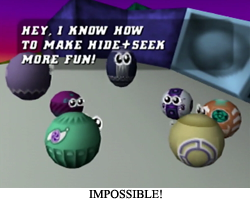
The fact that Nintendo would even bother salvaging this Jaguar leftover just goes to show how huge a deal the Game Boy Tetris was for Nintendo.
Much like Yoshi and Wario after it, Nintendo did a thing (got ahold of the Tetris license and made a portable version in this case), people really liked that thing, and now Nintendo’s going to milk that thing for everything it’s worth. Heck, both Yoshi and Wario starred in puzzle games chasing that Tetris money, and ol’ Yossy had three of the damn things. Nintendo of America’s insistence on slapping the Tetris license where it doesn’t belong is why we still haven’t gotten one lousy Virtual Console port of that Yoshi’s Island branded version of Panel De Pon.
[…] completely impossible to so much as touch in the normal, base games. I have played a lot of Tetris games over the years, but they’ve always been constrained by being… Tetris. Adding Puyo Puyo to Tetris creates a […]
[…] crowd at that point? Nintendo had already conquered that market in the portable sphere by bundling Tetris with the Gameboy. Going into 1995, Nintendo had a perfect record in America with bundling carefully […]